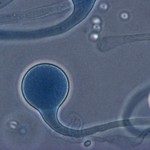Link to Pubmed [PMID] – 28101535
mSphere 2017 Jan-Feb;2(1)
Cryptococcosis is a potentially lethal disease of humans/animals caused by Cryptococcus neoformans and Cryptococcus gattii. Distinction between the two species is based on phenotypic and genotypic characteristics. Recently, it was proposed that C. neoformans be divided into two species and C. gattii into five species based on a phylogenetic analysis of 115 isolates. While this proposal adds to the knowledge about the genetic diversity and population structure of cryptococcosis agents, the published genotypes of 2,606 strains have already revealed more genetic diversity than is encompassed by seven species. Naming every clade as a separate species at this juncture will lead to continuing nomenclatural instability. In the absence of biological differences between clades and no consensus about how DNA sequence alone can delineate a species, we recommend using “Cryptococcus neoformans species complex” and “C. gattii species complex” as a practical intermediate step, rather than creating more species. This strategy recognizes genetic diversity without creating confusion.

